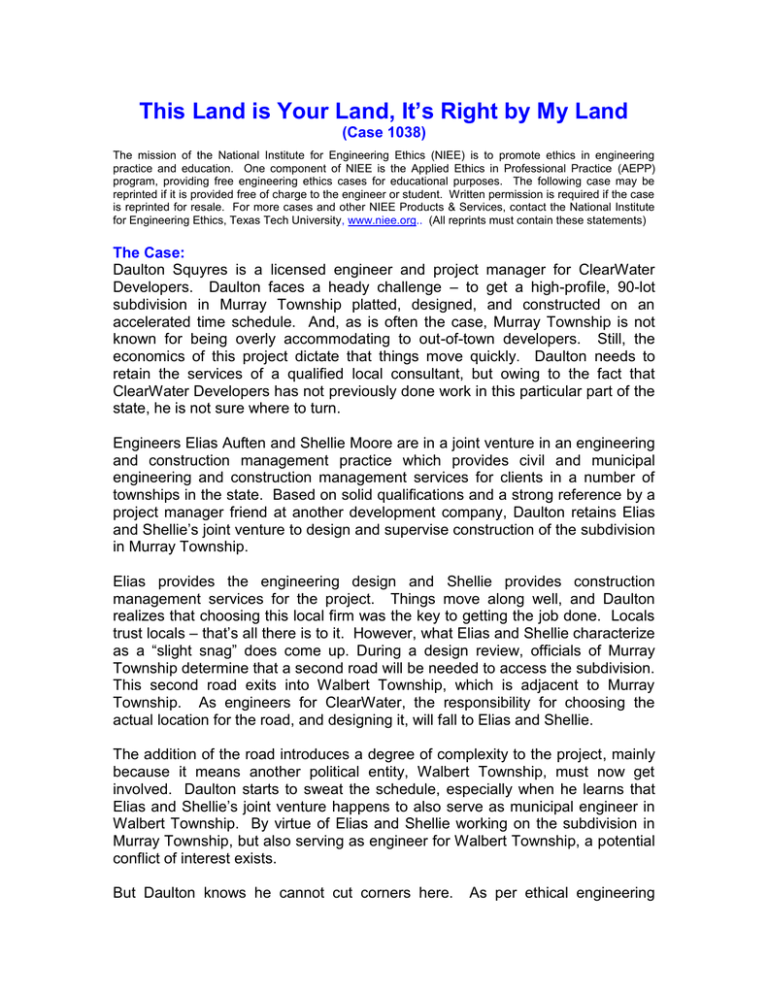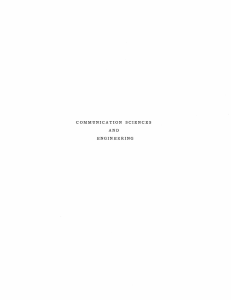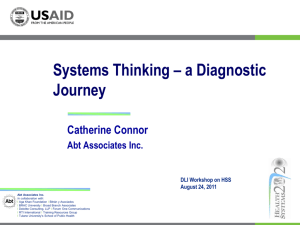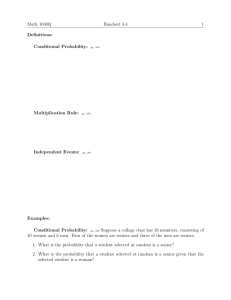It’s Right by My Land This Land is Your Land, (Case 1038)
advertisement

This Land is Your Land, It’s Right by My Land (Case 1038) The mission of the National Institute for Engineering Ethics (NIEE) is to promote ethics in engineering practice and education. One component of NIEE is the Applied Ethics in Professional Practice (AEPP) program, providing free engineering ethics cases for educational purposes. The following case may be reprinted if it is provided free of charge to the engineer or student. Written permission is required if the case is reprinted for resale. For more cases and other NIEE Products & Services, contact the National Institute for Engineering Ethics, Texas Tech University, www.niee.org.. (All reprints must contain these statements) The Case: Daulton Squyres is a licensed engineer and project manager for ClearWater Developers. Daulton faces a heady challenge – to get a high-profile, 90-lot subdivision in Murray Township platted, designed, and constructed on an accelerated time schedule. And, as is often the case, Murray Township is not known for being overly accommodating to out-of-town developers. Still, the economics of this project dictate that things move quickly. Daulton needs to retain the services of a qualified local consultant, but owing to the fact that ClearWater Developers has not previously done work in this particular part of the state, he is not sure where to turn. Engineers Elias Auften and Shellie Moore are in a joint venture in an engineering and construction management practice which provides civil and municipal engineering and construction management services for clients in a number of townships in the state. Based on solid qualifications and a strong reference by a project manager friend at another development company, Daulton retains Elias and Shellie’s joint venture to design and supervise construction of the subdivision in Murray Township. Elias provides the engineering design and Shellie provides construction management services for the project. Things move along well, and Daulton realizes that choosing this local firm was the key to getting the job done. Locals trust locals – that’s all there is to it. However, what Elias and Shellie characterize as a “slight snag” does come up. During a design review, officials of Murray Township determine that a second road will be needed to access the subdivision. This second road exits into Walbert Township, which is adjacent to Murray Township. As engineers for ClearWater, the responsibility for choosing the actual location for the road, and designing it, will fall to Elias and Shellie. The addition of the road introduces a degree of complexity to the project, mainly because it means another political entity, Walbert Township, must now get involved. Daulton starts to sweat the schedule, especially when he learns that Elias and Shellie’s joint venture happens to also serve as municipal engineer in Walbert Township. By virtue of Elias and Shellie working on the subdivision in Murray Township, but also serving as engineer for Walbert Township, a potential conflict of interest exists. But Daulton knows he cannot cut corners here. As per ethical engineering practice, the joint venture of Elias and Shellie discloses to Walbert Township its relationship with ClearWater Developers relative to the subdivision for Murray Township. On this basis, Walbert Township does not object to Elias and Shellie making a recommendation regarding the feasibility of the construction of the proposed road. Thereafter, as municipal engineer for Walbert Township, Elias and Shellie’s joint venture recommends that Walbert Township approve construction of the proposed road. This is excellent news for Daulton –he will make his schedule after all. The project moves forward, with Elias and Shellie modifying the design to include the new road. The addition of the road requires the previously unanticipated acquisition of property in Walbert Township, and Daulton contacts ClearWater’s corporate “land man” in the home office, Conner Williams, authorizing him to negotiate to purchase the property. A short while later, Daulton gets a call from Conner who asks him to come look at a surveyor’s plat associated with the “Walbert Road” property acquisition. The problem is, to facilitate the new road, it appears that ClearWater will have to purchase more land than they ever thought would be necessary. According to Conner, an astute landowner in Walbert is holding out for “big bucks.” He is unwilling to cooperate unless Clearwater agrees to buy not only what they asked for but also some nearby out-parcels that the landowner claims would not be worth much as stand-alone lots. Conner knows the opposite is true – property values will go up dramatically when the subdivision is built – and in his opinion, the landowner is engaging in what can be viewed as legalized extortion. Given the significance of the project, and the lack of viable alternatives, Daulton decides that ClearWater cannot afford further delays and deftly authorizes that Conner purchase the property needed for the second road. But as he is about to leave the room, Daulton’s eye catches a detail he had not noticed before. In the particular area of the surveyor’s plat which shows the outlying parcels that ClearWater will have to purchase, there is a significant parcel of land that the plat identifies as being owned by Elias and Shellie’s joint venture! At no time did Elias and Shellie ever mention that they owned this property; this was not part of their disclosure to Walbert Township or to anyone else. Daulton is stunned. By recommending construction of the second road into Walbert Township – the location of which they personally chose – Elias and Shellie have just enriched themselves! This new road will dramatically increase the value of their property, just as it will for the other landowner. Daulton also realizes something else: his land man is not aware of the situation. Being from out of town, Conner doesn’t know all of the project history and thus has not picked up on the significance of this point. The funny thing is, Daulton would never have learned about this if that greedy landowner hadn’t insisted that ClearWater purchase the outparcels – thus requiring that they and their adjacent properties be included on the plat! Taking the plat and accompanying field notes to his office, Daulton tells Conner that he wants to mull things over a bit. Back in his office, Daulton confirms that indeed, Elias and Shellie’s joint venture owns this undeveloped property in Walbert Township, and their property value will be positively affected by the construction of the new road. The implications make Daulton’s head swim. This is clearly an ethical problem for Elias and Shellie, since they did not disclose their land interest when they had the perfect opportunity to do so. Worse than that, even if their “engineering” recommendation to build the road was technically justifiable, at the very least, they will appear to be motivated by desire for self aggrandizement. And at the worst, politically, this could become a nightmare for ClearWater Developers. If the press got hold of this news, all the community good will Daulton labored to build would be lost and would be replaced with a watchdog attitude that would hamper everything. The project might never get built, and ClearWater’s investment would be lost. Slowly, Daulton begins to realize that if he were to reveal what Elias and Shellie are doing, ClearWater would surely suffer. At the same time, the thought crosses Daulton’s furrowed brow that his darkest fear could become his strongest defense. No bad things would happen if no one learned about Elias and Shellie’s land interest. They certainly don’t intend to tell anyone, and Daulton has good reason to think that Elias and Shellie believe their ploy remains undiscovered. Further, it would be easy enough for Daulton to discreetly have the plat reconfigured so that Elias and Shellie’s name is deleted, practically ensuring that no one would ever put “two and two” together. In this way, even if things were discovered later on, he could plead ignorance and direct the blame to Elias and Shellie. After all, they created this problem, not him. What should Daulton do? NOTE: This case is adapted, with permission, from the Opinions of the National Society of Professional Engineers (NSPE) Board of Ethical Review (BER), Case 97-4, “Conflict of Interest - Reviewing Own Work - Failure to Disclose Property of Ownership/Relationship of Developer.” We modified the facts and discussion for purposes of clarity and pedagogical effectiveness, and all person, place and business names herein are purely fictional. To view the original case and the actual findings of the NSPE BER, please access this case on-line at the website of the National Institute for Engineering Ethics: http://www.niee.org/cases/index.htm Alternate Approaches: 1. Let nature take its course. Daulton has done nothing wrong, and it would in fact be wrong for his project to suffer as a result of someone else’s misdeed. So as to not hinder the project, Daulton should say nothing and to do nothing. Perhaps no one will notice Elias and Shellie’s nearby land interest. If they don’t, that is good for Daulton. If by chance someone does notice Elias and Shellie’s land interest, hopefully by that time the project will have been built, Daulton can plead ignorance and dismay, and Elias and Shellie can face the consequences of their actions. Percentage of votes agreeing: 0% 2. Clean up the documents. It would be nice if somehow Daulton could get the project built without delay while at the same time bringing Elias and Shellie to justice. But Daulton can’t afford any delay, and even if it means that he “indirectly” aids and abets Elias and Shellie in their scheme, it is better that this issue never sees the light of day. Remember, this is not Daulton’s problem; it is Elias and Shellie’s. Daulton should direct that Elias and Shellie’s name be removed from the plat – virtually assuring that no one will notice their land interest – and go on with his business. Percentage of votes agreeing: 0% 3. Check things out. Daulton should retain a trusted engineer colleague in a nearby state to quietly provide him with a second opinion as to whether Elias and Shellie’s recommendation for the road was justified. The only valid concern here – if there is one – is whether Elias and Shellie are unjustly enriching themselves by means of the fact that they stand to personally gain from their land interest if the new Walbert road is built. Arguably, this influence might have corrupted their judgment. However, if their decision for the road stands on its own technical merit, politics and personalities aside, there was no corruption of judgment and there is no ethical problem. Percentage of votes agreeing: 8% 4. Call Elias and Shellie. A standard ethics provision is that engineers are to conduct themselves honorably so as to enhance the honor and reputation of the profession. At a bare minimum, this would mean giving Elias and Shellie the benefit of the doubt – things might not be what they seem. Daulton should invite Elias and Shellie to meet with him and Conner, show them what he has learned, appraise their response, and take it from there. Percentage of votes agreeing: 33% 5. Propose a civic donation. It is naïve to think that Elias and Shellie are innocent – Daulton has the information that condemns them! But, being civically minded, Daulton could use this opportunity to “encourage” Elias and Shellie to become strong supporters of both the Murray and Walbert communities. Having ascertained from Conner an estimate as to how much money Elias and Shellie stand to gain from the increase in their land value, Daulton should invite Elias and Shellie to a meeting where he shows them what he has learned and proposes that they generously donate this amount of money to both the Murray and the Walbert historic societies. Such a donation is the only reasonable way to ensure good will and future success of all parties concerned. Percentage of votes agreeing: 0% 6. Generate some revenue. It is naïve to think that Elias and Shellie are innocent – Daulton has the information that condemns them! But, Daulton is a businessman, so he could use this opportunity to generate some revenue for the company. Having ascertained from Conner an estimate as to how much money Elias and Shellie stand to gain from the increase in their land value, Daulton should invite Elias and Shellie to a meeting where he shows them what he has learned and suggests that they have made an error in their billings. Daulton could then propose that Elias and Shellie deduct twice this amount of money from their invoice for services rendered. This type of accounting entry is the only reasonable way to ensure good will and future success of all parties concerned. Percentage of votes agreeing: 0% 7. Get some input. Situations like this are why there are ethics experts and why there are lawyers. Daulton should make general inquiry to his local professional society, seeking their perspectives and advice. Further, Daulton should contact his company’s legal counsel, tell them what he knows, and have them advise him as to how proceed so as to best protect the interests of the company. Daulton should document everything for the file, and call the clients to apprise them that there might be a delay. Percentage of votes agreeing: 35% 8. Call Murray and Walbert Townships. Perhaps the best way to proceed is to let the locals take care of things. Maybe they really don’t mind if Elias and Shellie profit from the increase in land value, and in effect they would approve of things as they are. Daulton should inform representatives of Murray and Walbert Townships of what he has learned, point out what he believes are the ethical concerns, and let them take it from there. Percentage of votes agreeing: 4% 9. Call the State P.E. Board. Daulton knows that the state’s engineering practice act requires that engineers “…disclose all actual or potential conflicts of interest.” This means that Elias and Shellie have stepped cleanly into the cross-hairs of an ethics violation. Further, the state’s engineering practice act requires that Daulton report violations that he knows of. This one’s a no-brainer. Daulton should “turn in” Elias and Shellie. Percentage of votes agreeing: 19% 10. Call the Press. It has to be kept in mind that ClearWater Developers has done nothing wrong, and it is Daulton’s job to make sure that his firm and the project do not suffer as a result of Elias and Shellie’s apparent malfeasance. The best way to deal with this is to get public opinion on ClearWater’s side, fully and from the beginning. Proper “spin” will help Daulton and everyone else negotiate through the problem with minimal impact to the project. Daulton should leak what he knows to a reporter for the local papers, and let the press take it from there. Percentage of votes agreeing: 0% Forum Comments from Respondents 1. As soon as Daulton has discussed this matter with Elias and Shellie, he should discuss it with the two Townships so that all potentially affected parties are aware of the conflict. After discussion with the two townships, Daulton should remove Elias and Shellie from the project and replace them with a more ethical engineer. 2. Firstly Daulton should talk with the company's legal counsel. Depending on the advice they have for him, then it would be the correct course of action to inform the state PE board that members are in violation. 3. Before jumping to conclusions, Daulton should first call Elias and Shellie to find out for sure what the reasons are behind their actions. Once Daulton discusses the situation with Elias and Shellie, further actions can be taken. 4. A combination of option 4 (call Elias and Shellie) and option 9 (call the State P.E. Board) seems appropriate. In the event that the conversation with Elias and Shellie proves that Elias and Shellie are profiting personally from the sale of property, then the P.E. Board should be contacted. 5. Daulton should first check whether or not the road is necessary. If the road is not necessary, then it shouldn’t be built and Daulton should let Elias and Shellie know why. If the road is necessary, then Daulton should still let Elias and Shellie know what he knows and he should let them make the next move. 6. Daulton must act in his company's best interest in this case, especially if the new road will be costing his company more money. For this reason Daulton should place the decision in his company's hands. 7. Option 4 (call Elias and Shellie) seems to be the most ethical choice. It appears that the two engineers have overstepped their bounds; however, Daulton should confront them first and find out their story. He can then determine whether further action has to be taken. 8. As a professional courtesy it would be appropriate for Daulton to bring up the situation to Elias and Shellie first. Daulton should also ask someone who is impartial to the situation to look at the plans to see what is technically best. 9. Guideline #5 of ASCE's Standards of Professional conduct states that it is an employee's responsibility to protect an employer's "assets against loss, theft, and misuse." It also states in Section 4 #1 that "questions of guidance . . . may be asked anonymously." I feel these statements make alternative 7 (get some input) the most appropriate. 10. This is a difficult decision because Daulton does not know the exact intent of Elias and Shellie. He should confront both Elias and Shellie to learn more about them and their motives for building the road. Daulton also must contact his legal counsel because it is in his best interest to inform his company of a possible delay due to legal issues. 11. Ethically this dilemma centers on a huge conflict of interest for Elias and Shellie, and Daulton needs to inform the owner of Clearwater Developers about it. This problem has the potential to jeopardize the reputation of Daulton’s company, so the boss should know about the situation to get more professional advice. 12. Daulton should initiate a sit-down meeting with Elias, Shellie and Conner to find out what is really going on (as explained in approach #4). Then, with this input, Daulton should take what he and learned and seek advice from his local professional society and the company's legal counsel (as explained in approach #7). 13. I think that clearly Elias and Shellie are in the wrong, but at the same time we have to consider the client's interest, and how turning them in might delay the project. By communicating with his local professional society, and his company's legal counsel, Daulton would be able to make a more informed decision. Comments from Board of Review Members 1. The fact that Elias and Shellie own property in Walbert Township, the value of which will be positively affected by the new road they locate and design, is an actual – not potential – conflict of interest. This puts Elias and Shellie in the untenable situation of having to serve two masters: the client or themselves. Disclosure of this land interest would not be sufficient to allay the problem; the obvious course of action would be for Elias and Shellie to divest themselves of the property or decline to work on the project. But Elias and Shellie did not disclose their land interest. Instead they said nothing, and their failure to disclose an actual conflict of interest is tantamount to deception. As much as he might wish to do so, Daulton cannot simply sweep this under the rug. Elias and Shellie are clearly in violation of engineering law and the code of ethics. The obvious place to start is communication with his company's legal counsel. From there, Daulton should contact Murray and Walbert Townships, and then perhaps convene a meeting with Elias and Shellie.



